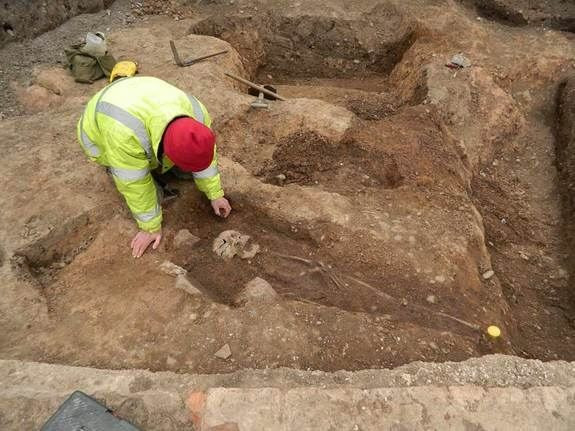
Archaeologists have discovered a 1,700-year-old Roman cemetery that seemed to show no religious bias beneath a parking lot in Leicester, England. Located at the junction of present day Newarke and Oxford Streets, numerous burials and skeletal remains from 13 individuals, both male and female, have been recovered from the site.
The cemetery is estimated to date back to around A.D. 300.
"We have literally only just finished the excavation and the finds are currently in the process of being cleaned and catalogued so that they can then be analyzed by the various specialists," John Thomas, archaeological project officer.
2013 has so far been a good year for finding burial sites beneath parking lots in the UK. In February, an excavation beneath another parking lot in Leicester unearthed bones that "beyond reasonable doubt" were identified as belonging to the English King Richard III. Recently in Scotland, the skeletal remains of a medieval knight and possibly his family crypt were also unearthed from beneath a parking lot as well.
Prior excavations on Newarke Street, at burial sites located east and north of where the recent Roman cemetery was uncovered, had unearthed internment practices that follow alongside Christian traditions; these traditions include bodies buried in a supine position, facing east with little or no goods buried alongside them.
"Unusually the 13 burials found during the recent excavations, of mixed age and sex, displayed a variety of burial traditions, including east to west and north to south-oriented graves," said Thomas. "Many with personal items such as finger rings, hairpins, buckles and hob-nailed shoes."
Some of the graves display paganlike traditions, with one grave facing north-south with the body positioned on its side in a semi-fetal position. The head was removed and placed near the feet alongside two pottery jars, most likely as offerings for the journey to the afterlife. "This would seem to be a very pagan burial," according to Thomas.
Nearby to this grave was a burial that displayed very Christian characteristics; the individual was facing east and wearing a polished ring made of jet on their left hand. The ring had an "IX" designed etched onto it, which may have been decorative or could represent an early Christian symbol taken from the initials of Christ in Greek, known as Iota-Chi or IX.
"If so, this would represent rare evidence for a personal statement of belief from this period," Thomas said in a statement.
From the mix of burial types, Thomas said it's possible "that the cemetery catered for a range of beliefs that would have been important to people living in Leicester at this time."
Alongside these burials, archaeologists have also discovered a 17th-century ditch running alongside Newarke Street, which they believe might have been part of the town's defenses during the English Civil War. The project in Leicester is ongoing and archaeologists and other scientists are going to analyze the human bones in order to determine age, sex and the likely cause of death.
"It is possible that study of the bones will also enlighten us to patterns in the individuals' diet, and wear and tear on the bones may shed light on their lifestyle or the stress put on their bodies through work," Thomas wrote. "We have also taken soil samples from the stomach area of the bodies to look for gut parasites."
© 2025 Latin Times. All rights reserved. Do not reproduce without permission.




